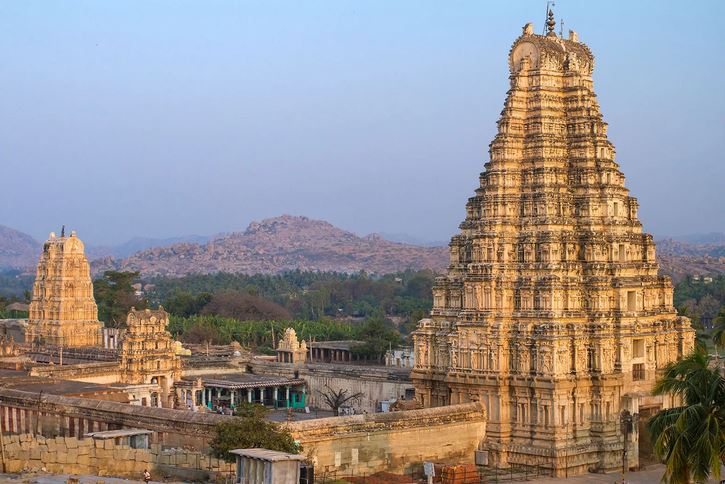Note4Students
From UPSC perspective, the following things are important :
Prelims level: Virupaksha Temple, Vijayanagara Empire
Mains level: NA

Why in the News?
The temple’s pavilion or the Saalu Mantap of the historic Virupaksha Temple in Hampi, Karnataka collapsed following Torrential rains.
About Virupaksha Temple
|
Architectural Features of Virupaksha Temple
Here are the major Dravidian architectural features of the Virupaksha Temple:
Gopurams (Temple Towers):
- Main Gopuram: The eastern entrance of the temple features a monumental nine-story gopuram (tower) that is approximately 50 meters high. This tower is intricately decorated with sculptures depicting Hindu myths and deities.
- Smaller Gopurams: Other entrances of the temple are also marked by smaller but similarly elaborate gopurams.
Mandapas (Pavilions):
- Ranga Mandapa: Added in 1510 by King Krishnadevaraya, this is one of the most elaborately carved areas. The Ranga Mandapa is used for temple ceremonies and performances, featuring pillars with intricate carvings of mythical creatures and deities.
- Open Pillar Hall: A large hall with rows of intricately carved pillars that depict various mythological scenes and form an important part of the temple structure.
- Kalyana Mandapa: This area is used for celebrating the annual marriage festival of the deities, reflecting both architectural grandeur and cultural significance.
Sanctum Sanctorum (Garbhagriha):
- Main Shrine: The innermost sanctum houses the sacred Linga of Lord Virupaksha (Shiva). This area is considered the most sacred and is elaborately decorated.
- Lesser Sanctums: Surrounding the main sanctum, there are smaller shrines dedicated to other deities, which are typical in South Indian temple complexes.
Pillars and Sculptures:
- Carved Pillars: The temple’s pillars are renowned for their detailed carvings, which depict scenes from Hindu mythology, including episodes from the epics like the Ramayana and the Mahabharata.
- Artistic Themes: The sculptures include a mix of divine figures, mythological animals, and scenes from daily life, showcasing the craftsmanship and artistic sensibilities of the era.
Water Structures:
- Sacred Tank: A sacred water tank within the complex is used for religious rituals and ceremonies.
About Vijayanagara Empire
|
PYQ:[2019] Building ‘Kalyana Mandapas’ was a notable feature in the temple construction in the kingdom of-
[2016] Krishnadeva Raya, the king of Vijayanagar, was not only an accomplished scholar himself but was a also a great patron of learning and literature. Discuss. |
Get an IAS/IPS ranker as your 1: 1 personal mentor for UPSC 2024

